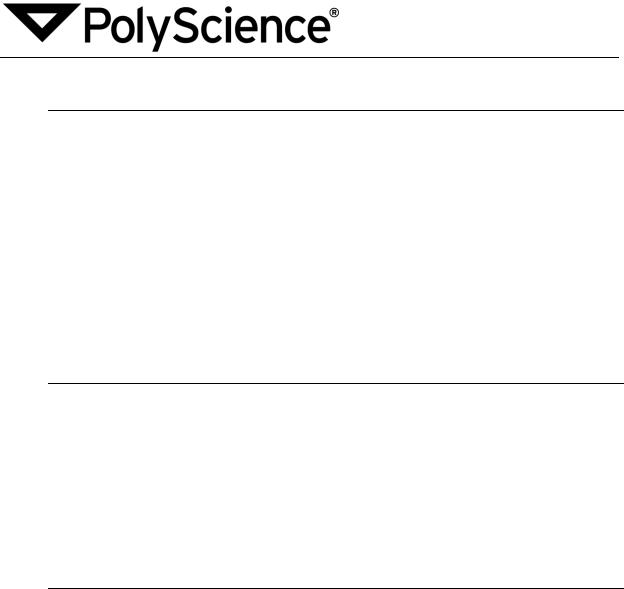PolyScience Polyclean Algaecide Data sheet

|
|
|
|
MATERAL SAFETY DATA SHEET |
||
|
PRODUCT NAME: |
polyclean |
PRODUCT ID: PVL 450-588 |
|
||
|
REVISION DATE: |
11/23/2010 |
SUPERCEDES: 10-30-2008 |
|||
1. IDENTIFICATION OF THE SUBSTANCE AND COMPANY |
|
|
||||
|
|
|
||||
Chemical Name: |
Poly(oxyethlene (dimenthyliminio)ethylene – (dimethyliminio) ethylene dichloride). |
|||||
Similar names: |
Poly 15 Algaecide |
|
|
|
||
Trade names: |
WSCP, Algaecide 15, 15% Algaecide |
|
|
|||
Chemical Family: |
Polymer, Algaecide 15% by weight |
|
|
|||
EPA reg. no. |
48520-14 -87892 |
EPA Est no. |
48520-CT-002 |
|||
CAS no. |
31512-74-0 |
|
|
|
||
Product Description: |
|
Clear pale yellow/ brown liquid having a slight odor. |
||||
Type of Product and use: |
Algaecide for laboratory use. |
|
|
|||
Supplier: Phoenix Products Company |
Distributor: |
PolyScience |
||||
|
55 Container Drive |
|
|
6600 W. Touhy Ave. |
||
|
Terryville, CT 06786 |
|
Niles, IL 60714 |
|||
|
Telephone: (860)589-7502 |
|
Telephone: (847)647-0611 |
|||
Emergency Telephone: U.S. PERS Emergency Telephone 1-800-633-8253 |
|
|
||||
2. HAZARDS IDENTIFICATION |
|
|
|
|||
|
|
|
|
|
||
EMERGENCY OVERVIEW: |
Clear liquid |
|
|
|||
|
|
|
Irritating to eyes |
|
|
|
|
|
|
Harmful if inhaled or swallowed |
|
|
|
POTENTIAL HEALTH EFFECTS: |
|
|
|
|||
|
Eye Contact: |
Irritating to eyes, produces minimal effects in the form of erthema, chemosis, and discharge. |
||||
|
Skin Contact: |
Will not cause skin irritation. |
|
|
|
|
|
Inhalation: |
Harmful if inhaled. |
|
|
|
|
|
Ingestion: |
Harmful if swallowed. |
|
|
|
|
NFPA Ratings (0-4): |
|
Health |
1 |
|
|
|
|
|
|
Fire |
1 |
|
|
|
|
|
Reactivity |
0 |
|
|
HMIS Ratings (0-4): |
|
Health |
1 |
|
|
|
|
|
|
Fire |
1 |
|
|
|
|
|
Reactivity |
0 |
|
|
3. COMPOSITION / INGREDIENTS INFORMATION
COMPONENTS |
CAS NO. |
WEIGHT % |
Poly[oxyethylene(dimethyliminio)ethylene( |
31512-74-0 |
14.5-16.1 |
dimethyliminio)ethylene dichloride] |
|
|
Water |
7732-18-5 |
82.5-87.5 |
Phoenix Products Company MSDS 11-23-2010
Page 1

MATERAL SAFETY DATA SHEET
4. FIRST AID MEASURES
EYE CONTACT: Flush immediately with copious amounts of tap water or normal saline (minimum of 15 minutes). Take exposed individual to a health care professional, preferably an ophthalmologist, for further evaluation.
SKIN CONTACT: Wash exposed area with plenty of water. Repeat washing. Remove contaminated clothing and wash thoroughly before reuse. If irritation persists consult a health care professional.
INHALATION: If inhaled, immediately move person to fresh air. If individual experiences nausea, headache, dizziness, has difficulty breathing or is cyanotic, seek a health care professional immediately.
INGESTION: DO NOT INDUCE VOMITING. Rinse with copious amounts of water or milk. Irrigate the esophagus and dilute stomach contents by slowly giving one (1) to two (2) glasses of water or milk. Avoid giving alcohol or alcohol related products. In cases where the individual is semicomatose, comatose, or convulsing, DO NOT GIVE FLUIDS BY MOUTH. Take individual to nearest medical facility.
5. FIRE-FIGHTING MEASURES
Suitable extinguishing media: Water fog, carbon dioxide, foam, dry chemical.
Extinguishing media not to be used: N/A.
Fire Fighting Procedure: Fire fighters should wear full protective clothing and self-contained breathing apparatus (SCBA) in positive pressure mode.
Cool containers with water spray. On small fires, use water spray or fog. On large fires, use heavy deluge or fog streams. Flooding amounts of water may be required before extinguishment can be accomplished.
Unusual fire and explosion hazards: None.
6. ACCIDENTAL RELEASE MEASURES
PERSONAL PRECAUTIONS: Before responding to a spill or leak of this product, review each section of MSDS. Follow recommendations given in STORAGE AND HANDLING sections. Check Fire and Explosion Data to determine if the use of non-sparking tools is merited. Insure that spilled or leaked product does not come into contact with materials listed as incompatible. If irritating fumes are present, consider evacuation of enclosed areas.
METHODS FOR CLEANING UP: Initially minimize area affected by spill or leak. Block any potential routes to water systems (e.g. sewers, streams, lakes, etc.). Based on the product’s toxicological and chemical properties, and on the size and location of the spill or leak, assess the impact on contaminated environments (e.g. water systems, ground, air equipment, etc). There are no methods available to completely eliminate any toxicity this product may have on aquatic environments. Determine if federal, state and/or local release notification is required (see Regulatory Classifications section of this MSDS). Recover as much of the pure product as possible into appropriate containers. Later, determine if recovered product can be used for its intended use. Address cleanup of any contaminated environments. Spill or leak residuals may have to be collected and disposed of. Clay, soil, or commercially available absorbents may be used to recover any material that can not be readily recovered as pure product. Flushing residual material to an industrial sewer, if present at the site of a spill or leak incident, may be acceptable if authorized approval is obtained first. Insure any flushed materials do not come in contact with incompatible material. Contact person(s) responsible for the operation of your facility’s industrial sewer system prior to discharge.
Phoenix Products Company MSDS 11-23-2010
Page 2
